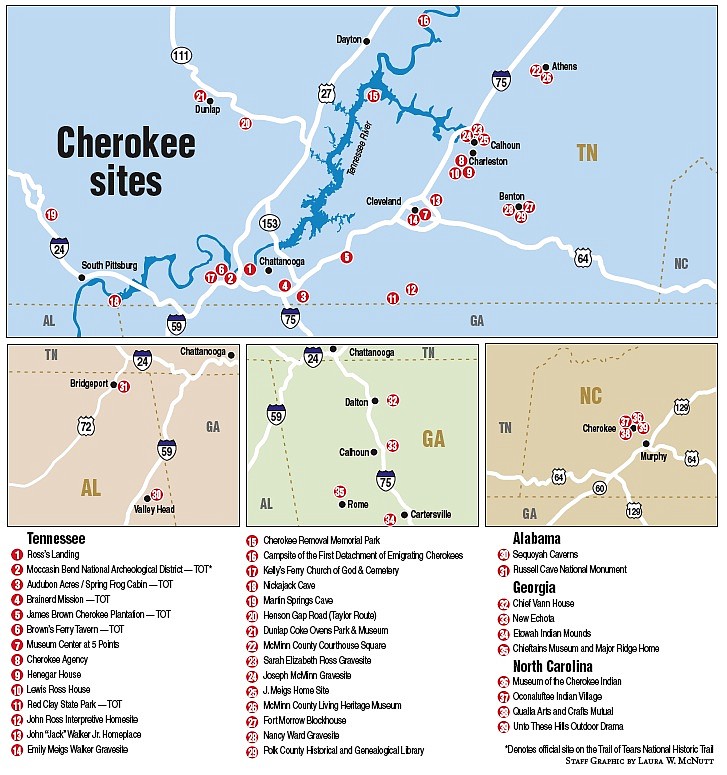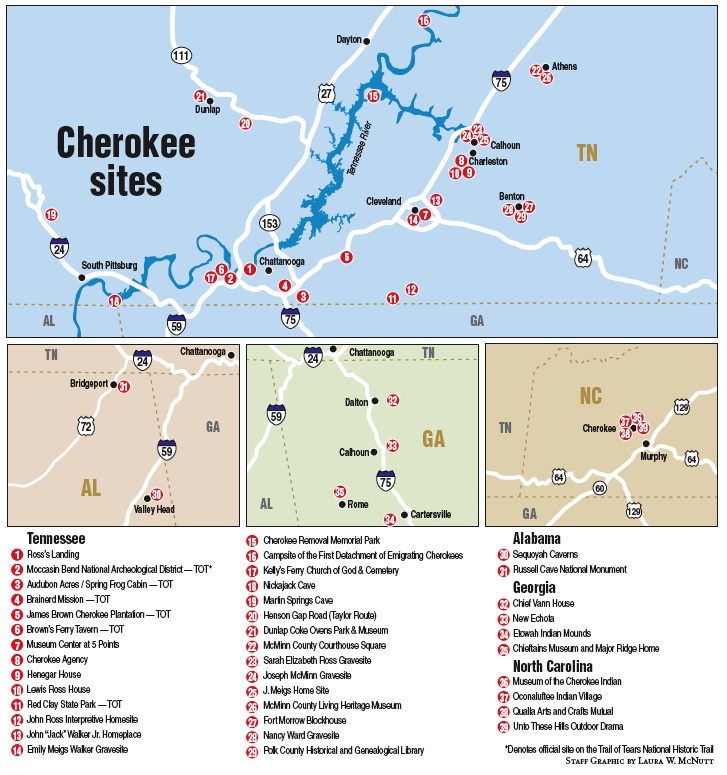If you're looking for an off-the-beaten-path day or weekend trip with history lessons, the Southeast's American Indian sites can't be beat.
From Red Clay in Cleveland, Tenn., and Ross's Landing in Chattanooga to New Echota in Calhoun, Ga., and Sequoyah Caverns near Fort Payne, Ala., it's clear that American Indians built the region's history and flavor.
In 1825, the Cherokees established New Echota at the headwaters of the Oostanaula River near what is now Calhoun. It was the Cherokee capital before the Treaty of New Echota and new Georgia laws, prompted by rumors of gold, barred Cherokees from the Peach State and paved the way for the Trail of Tears.
Although its history was short, New Echota became the site of the first Indian-language newspaper office and one of the earliest experiments in national self-government by an Indian tribe. It also was the birthplace of a court case that carried to the U.S. Supreme Court, and it was where the Treaty of New Echota was signed. It was that treaty that relinquished Cherokee claims to lands east of the Mississippi River.
"New Echota is a fascinating place to spend an afternoon," said Kim Hatcher, spokeswoman for the Georgia Department of Natural Resources. "Many people don't realize that the Cherokee Nation had a government much like the U.S. government, and some people are even surprised to learn that the Cherokee lived in traditional houses, not teepees, which are so often associated with Native Americans."
Today, from Thursdays through Saturdays at the New Echota Cherokee Capital Historic Site, visitors can see several original and reconstructed buildings, including the Council House, courthouse, print shop, missionary Samuel Worcester's home and an 1805 store, as well as outbuildings such as smokehouses, corncribs and barns.
In the visitor's center, guests can purchase original American Indian arts, crafts and music and view interpretive exhibits and a 17-minute film.
Just over 50 miles to the north, near Cleveland, Tenn., the 150-acre Red Clay State Park memorializes the last capital of the Cherokee Nation in the east. Known as the Red Clay Council Ground, this is where the Cherokee nation's diplomatic efforts continued as the people tried to avoid removal on what became the Trail of Tears.
The site includes a museum, outdoor replicas of an 1830s Cherokee council house, sleeping huts, a farmstead and a monument known as the Eternal Flame of the Cherokee Nation.
In Chattanooga, Moccasin Bend National Archeological District eventually may become the largest memorial to this rich American Indian history, but for now it is still being designed for eventual construction. No date is set.
Things are moving forward on the design, said Shelley Andrews, executive director of Friends of Moccasin Bend Park.
"The biggest hurdle we have now is funding for the interpretive center, but in the meantime we want the public to be able to access the Bend even if there is not a building," she said.
By the end of the year, she said, the Friends and officials with Chickamauga and Chattanooga National Military Park, which manages the Bend, hope to have a new trail open that will include a Trail of Tears site.
In the meantime, there are plenty of other historical American Indian sites to visit, including Cherokee, N.C., just a few hours to the northeast.
TENNESSEE
-- Ross's Landing and the Passage -- in Chattanooga. Established in 1816 by John Ross at the foot of what is now the Market Street Bridge. Ross had a ferry, a store and a warehouse at the crossroads of river and highway traffic that eventually would become Chattanooga. The site of Ross's Landing is on the National Register of Historic Places.
The Passage, a popular part of the Tennessee Riverwalk beside the Tennessee Aquarium, memorializes the Cherokees in the Southeast. Seven, 6-foot ceramic disks and 16 stainless steel sculptures line the wall facing the river, and plaques educate visitors about games and the Cherokee culture. The water flowing down the passage and out to the river is symbolic of the tears shed as the Cherokees were driven from their homes, and seven cannons shoot water up and out into the river.
-- Moccasin Bend National Archaeological District -- in Chattanooga. This is a park in the making. The prominent peninsula of the Tennessee River shaped like a moccasin lies just west of Chattanooga and holds history from more than 10,000 years of human habitation. The Bend also holds a Trail of Tears river crossing site and several important Civil War cannon placements.
-- Audubon Acres/Spring Frog Cabin -- in East Brainerd. This wildlife sanctuary holds a pre-removal Cherokee dwelling known as the Spring Frog Cabin. Tooan Tuh, or Spring Frog, was a prominent Cherokee chief. The site is listed on the National Register of Historic Places.
-- Brainerd Mission -- near Eastgate in Chattanooga. This was a missionary school and church founded in 1817 to educate and convert the Cherokees to Christianity. Now all that is left is a cemetery on one acre filled with large Southern red oaks. The site is on the National Register of Historic Places.
-- Cherokee Removal Memorial Park -- at Blythe's Ferry near Birchwood. In 1809, Cherokee William Blythe operated a ferry at the confluence of the Tennessee and Hiwassee rivers. The ferry later transported nine Cherokee detachments -- about 10,000 people -- across the Tennessee River in the fall of 1838 as part of the north route of the Trail of Tears. A boardwalk leads from the memorial monument to a wildlife overlook shelter on top of the bluff offering views of the river and Jolly's Island. A granite wall dedicated to those who passed through the Trail of Tears extends throughout the park.
-- Nancy Ward Gravesite -- near Benton. Nancy Ward was known as "Beloved Woman" by the Cherokee. She helped negotiate relationships between the Cherokee people and white settlers and took part in treaty negotiations. A monument erected in 1923 by the Nancy Ward Chapter of the Daughters of the American Revolution marks her grave.
GEORGIA
-- Chief Vann House -- in Chatsworth. Built in 1804, the two-story brick home was the showplace of the Cherokee Nation and made it clear that the Cherokee were anything but savages. During the 1790s, James Vann became a Cherokee leader and wealthy businessman. He established the largest and most prosperous plantation in the Cherokee Nation, covering 1,000 acres of what is now Murray County.
-- Historic Etowah Indian Mounds -- in Cartersville. Home to several thousand American Indians between 1000 A.D. to 1550 A.D., this 54-acre site contains six earthen mounds, a plaza, village area, borrow pits and a defensive ditch. Many artifacts show how the natives decorated themselves with shell beads, tattoos, paint, complicated hairdos, feathers and copper ear ornaments.
ALABAMA
-- Sequoyah Caverns -- in Valley Head. Cherokee and Creek Indians lived in and around the caverns, and early explorations by homesteader Abner Ellis found salt troughs, cooking pottery and other artifacts in the large entrance room, along with smoke-blackened walls and ceiling. The caverns are named for the famed Cherokee Sequoyah, whose family lived nearby.
-- Russell Cave National Monument -- in Bridgeport. The cave shelter preserves 10,000-plus years of occupation by prehistoric people. Artifacts can be seen in the visitor center museum, and living history demonstrations and video programs are offered.

